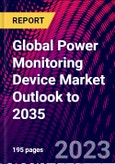The global power monitoring device market is anticipated to grow with a CAGR of ~5.7% over the forecast period, i.e., 2023 - 2035. Factors such as the increase in electric bills leading to the rise in concerns for lowering the cost of electricity is projected to drive the growth of the market in the coming years. Additionally, the increasing number of smart grid deployment projects is also expected to boost the market growth. The market is estimated to garner a revenue of near to nearly USD 6,360 million by the end of 2035, up from a revenue of about USD 3,4980 million in the year 2022.
The global power monitoring device market is segmented into numerous segments, which include segmentation by device, end-user, and by region. By device, the market is segmented into measuring & monitoring systems, and metering & communication devices. By the end of 2035, the measuring & monitoring systems segment is anticipated to garner the largest revenue of around USD 3,810 million, up from a revenue of close to USD 2,150 million in the year 2022. Growing installations of smart grids and smart metering, which would ultimately warrant the need for measuring and monitoring systems, are bolstering the prospects of the segment for the forecast years. Moreover, measuring and monitoring the system's continuous tracking of energy-related data gives information on an electrical system's operational parameters. This covers the loads that are using the energy, where, when, and how those loads are using it. All the electrical system's energy delivery and consumption can be decreased with the aid of this knowledge.
On the basis of region, the global power monitoring device market is segmented into North America, Europe, Asia Pacific, Latin America and Middle East & Africa. The market in North America, amongst the market in all the other regions, is anticipated to garner the largest revenue of more than USD 2,030 million by the end of 2035. Moreover, in the year 2022, the market in the region generated a revenue of over USD 1,1580 million. The region's power monitoring market is expanding dramatically, in large part owing to the quick adoption of smart grid technology and investments in IT hubs and data centres. For instance, a report produced by the US International Trade Commission predicted that by the end of 2020, the adoption of smart grids will dramatically grow. Furthermore, there has been a presence of key market players in the region that are investing in the advancement of power monitoring devices, and it is projected to drive the growth of the market in the North America region.
Some of the prominent industry leaders in the global power monitoring device market that are included in our report are Schneider Electric, ABB Ltd, Siemens Aktiengesellschaft, Emerson Electric Co., FINDER S.p.A., PHOENIX CONTACT, Weidmüller Interface GmbH & Co. KG, Yokogawa Electric Corporation, OMRON Corporation, Fuji Electric FA Components & Systems Co., Ltd., Rockwell Automation Inc., and others.
The global power monitoring device market is segmented into numerous segments, which include segmentation by device, end-user, and by region. By device, the market is segmented into measuring & monitoring systems, and metering & communication devices. By the end of 2035, the measuring & monitoring systems segment is anticipated to garner the largest revenue of around USD 3,810 million, up from a revenue of close to USD 2,150 million in the year 2022. Growing installations of smart grids and smart metering, which would ultimately warrant the need for measuring and monitoring systems, are bolstering the prospects of the segment for the forecast years. Moreover, measuring and monitoring the system's continuous tracking of energy-related data gives information on an electrical system's operational parameters. This covers the loads that are using the energy, where, when, and how those loads are using it. All the electrical system's energy delivery and consumption can be decreased with the aid of this knowledge.
On the basis of region, the global power monitoring device market is segmented into North America, Europe, Asia Pacific, Latin America and Middle East & Africa. The market in North America, amongst the market in all the other regions, is anticipated to garner the largest revenue of more than USD 2,030 million by the end of 2035. Moreover, in the year 2022, the market in the region generated a revenue of over USD 1,1580 million. The region's power monitoring market is expanding dramatically, in large part owing to the quick adoption of smart grid technology and investments in IT hubs and data centres. For instance, a report produced by the US International Trade Commission predicted that by the end of 2020, the adoption of smart grids will dramatically grow. Furthermore, there has been a presence of key market players in the region that are investing in the advancement of power monitoring devices, and it is projected to drive the growth of the market in the North America region.
Some of the prominent industry leaders in the global power monitoring device market that are included in our report are Schneider Electric, ABB Ltd, Siemens Aktiengesellschaft, Emerson Electric Co., FINDER S.p.A., PHOENIX CONTACT, Weidmüller Interface GmbH & Co. KG, Yokogawa Electric Corporation, OMRON Corporation, Fuji Electric FA Components & Systems Co., Ltd., Rockwell Automation Inc., and others.
Table of Contents
1. An Outline of the Power Monitoring Device Market
3. Research Methodology & Approach
5. Forces of the Market Constituents
11. Global Economic Outlook: Challenges for Global Recovery and its Impact on Global Power Monitoring Device Market
23. Competitive Model: A Detailed Inside View for Investors
24. Global Power Monitoring Device Market 2022-2035 Outlook & Projections, Opportunity Assessment, 2022 to 2035
Companies Mentioned
- Schneider Electric
- ABB Ltd
- Siemens Aktiengesellschaft
- Emerson Electric Co.
- FINDER S.p.A.
- PHOENIX CONTACT
- Weidmüller Interface GmbH & Co. KG
- Yokogawa Electric Corporation
- OMRON Corporation
- Fuji Electric FA Components & Systems Co. Ltd.
- Rockwell Automation Inc.








